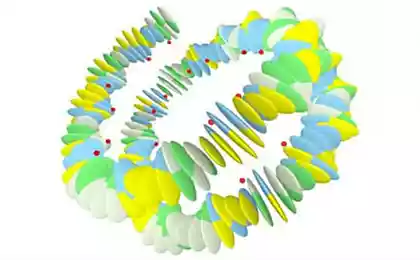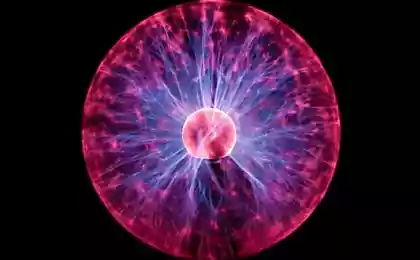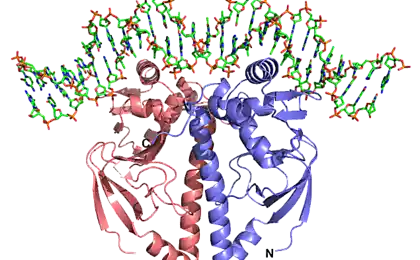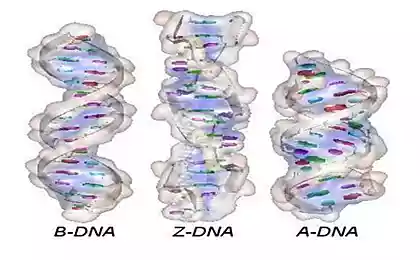654
Intracellular automation of DNA and proteins
How does intracellular automation?
Each cell has thousands of genes. Never so that they all worked simultaneously. Cells of muscles, liver and brain are the same set of genes. They are different because they have different genes. All cells have the ability to turn on and off individual genes in response to different external influences. That is the system which controls the activity of genes is a system of automatic control. Scientists want to understand how this automation works to be able to fix and hack. For example, in human cells there is a system of about three hundred genes and proteins that controls cell division.When it breaks down and the cell starts all the time to share, there is cancer.

A simplified diagram of the gene network regulating the cell division human
In the "iron" commonly used electrical impulses. Signals in biology, usually chemical, that is, the change in the concentration of some substances. In the nervous system are electrical signals, but it is just a device bystroi long distance transmission, like optical fiber technology. The transmission of nerve impulses from cell to cell occurs in the chemical form long-term memory and complex integration of signals in the neuron is also chemical.
Where there are signals, there will be crosstalk signals are not in place and noise is a random garbage, adhering to the signals. In electronics the arrival of signals at the address provided by the wires and insulation. Interferences arise due to parasitic capacitive and inductive coupling between conductors. In the bacterial cell, its contents are more or less evenly mixed, and any chemical signal (and thousands of them) available at any point. The cells of animals and plants are divided into compartments with different chemical composition, but the types of the compartments is less than a dozen and each has hundreds of thousands of different substances.
The arrival of the signal to the desired location of the cell occurs thanks to the molecular recognition principle "key-lock". One protein molecule can recognize another protein, protein can recognize a specific DNA sequence, the protein can recognize small molecules such as sugar.This recognition is not always perfectly accurate, so the molecules, similar in shape to a regular partner recognition to generate leads. In addition to the pickups, the electronics noise. They arise from the thermal motion of the atoms, which contributes a share of chaos in the motion of electrons. In the cell the chemical noise is also associated with thermal movement. When the signal is weak, for example, ten molecules of this type in the entire cell, these molecules will be scattered on the cage by accident, and not the fact that evenly. As a result of their concentration in a certain corner of a cell will randomly fluctuate, and it will be noise.
What exactly is regulated in the living cell?The cell can be viewed as a factory that produces all the necessary equipment and can collect from him a second plant. The main equipment are ribosomes, the machines that collect all the proteins. The structure of the collected protein on the tape —messenger RNA (mRNA). The ribosome moves along the mRNA and the user assembles a new protein chain of individual units known as amino acids. The outputof Asa from the ribosome the protein chain folds into a compact tangle of the Mature protein, which starts to work. Proteins can speed up chemical reactions (enzymes), as well as to engage in the transport of substances, signaling, protection and many other things.
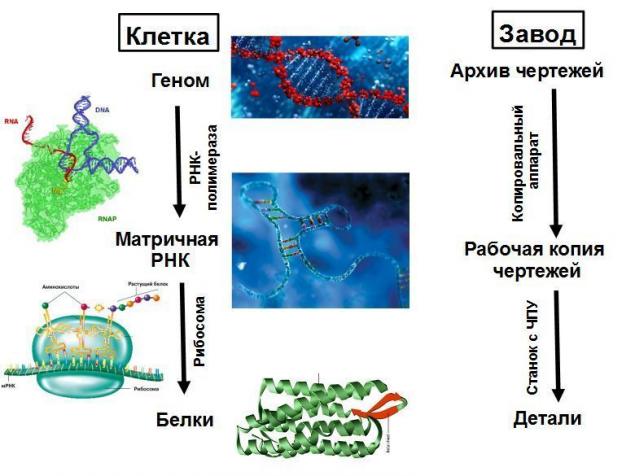
mRNA is formed as copies of individual sections of cell DNA. DNA can be compared with the archive of technical documentation in the office of the chief engineer, and mRNA — copies of the drawings issued to the shop. Copy machine, creating these copies is also is a protein called RNA polymerase. She can sit on the DNA and begin copying not everywhere, but only on special sites, DNA promoters, which are located in front of each gene or group of genes working together.
Switching on and off of genes is mainly in the landing phase of RNA polymerase to the promoter. If RNA polymerase easily sits on the promoter of the gene, then it is a lot of mRNA copies and ribosomes to produce many molecules of the protein encoded by this gene is included he will. If something will prevent the planting of RNA polymerase, the gene will be switched off. That is, the turning on and turning off of genes occurs at the stage of interaction of RNA polymerase and promoter. Various other molecules that can help or interfere with their binding. These other molecules, primarily special regulatory proteins with promoter and neighboring stretches of DNA form a logical element that can integrate several different input signals.
Logic elements on DNA and proteins is Perhaps the most susannaspeier gene switch — lactose operon of Escherichia coli. The Frenchmen Jacob and Monod in his research was awarded the Nobel prize in 1965. E. coli, as is clear from its name, lives in the intestine.This may be the intestines of various animals, from bees to humans. She's going to eat what caught the master so it can have many different nutrients.

E. coli under the microscope and Petri dish
E. coli can grow, for example, on a nutrient medium consisting of only glucose and mineral salts and produce all the necessary amino acids and vitamins. Instead of glucose may be other sugar (fructose, malt sugar — maltose, milk sugar — lactose, and a dozen others), as well as polysaccharides, such as starch.
For the assimilation of each of these sugars need their enzymes.The production of these enzymes is to run only when the relevant sugar is in the environment, or materials and energy for production of these enzymes will be wasted. That is, the genes of these enzymes for the assimilation of sugars should be included only when there is the sugar. For the assimilation of each sugar should, as a rule, several enzymes, not just one. Their genes are in the DNA chain nearby and their activity is controlled by one common regulatory DNA sequence in the beginning of the first gene.Such a group working together and synchronously controlled genes is called "operon".

The scheme of the lactose operon
Lactose operon consists of three genes. The first (LacZ) encodes a transport protein, the lactose is pumped into the cell, and the other two (LacI and LacA) — enzymes that work together to converts the lactose in the "default sugar" — glucose. At the beginning of the lactose operon is a binding site of RNA polymerase (the promoter) and a plot of the binding of regulatory proteins (the operator).
The activity of the lactose operon is controlled by two signals.The first signal is, obviously, the concentration of lactose. If lactose is not present, and the enzyme digestion is not necessary. The second signal was a little harder. In one of the experiments, Jacob and Monod were raised E. coli on medium containing both lactose and glucose. In such circumstances, the first coli consumes glucose and lactose operon it off. When glucose is over, bacterial growth is suspended for 15-20 minutes and then continues at the expense of lactose. During the pause of the lactose operon is switched on. That is, the second regulatory sign-off lactose operon when the cell has more available sugar than lactose (glucose uptake does not require any additional enzymes).
Further experiments showed that the lactose operon does not respond to glucose itself. Instead, within the cells of Escherichia coli the level of hunger (or rather, "Goodies" available sugars) is coded with a special signal substance. It's called "cyclic adenosine monophosphate", or camp. While coli is growing on glucose, camp in the cell is almost none. If there is no glucose, but maltose or starch (a little over trudnosmyvaemye substances) produced little camp. If there is no maltose, but have fructose or lactose, camp levels in the cell will be higher. If there are no sugars, but there is a lactic acid — even higher, and finally, if anything is not delicious and have to eat the glycerin, the level of camp will be the highest.Thus, the lactose operon is controlled by two signals: the concentration of lactose and the concentration camp.
How these signals act on the activity of genes? The active gene is one in which RNA polymerase produces a lot of messenger RNA. RNA polymerase begins work on the operon are always landing on the same piece of DNA (called "the promoter"). Where there is a choice for lactose and camp? RNA polymerase cannot recognize all the hundreds of signals that regulate the activity of thousands of genes. For this there are special regulatory proteins (called "transcription factors"). In the management of lactose operon regulatory protein, involved two, one for each input: lactose catabolic repressor and activator.

Lactose repressor (purple) for DNA
Lactose repressor is a protein that is able to communicate either with lactose or with a specific DNA sequence. In the genome of E. coli there are two such sequences, both at the beginning of the lactose operon, on either side of the promoter. The lactose repressor molecules firmly sticking together with each other in groups of four protein molecules.Linking such four DNA twists a strand of DNA into a steep loop, which is the promoter.RNA polymerase can't get on, a shrewd promoter and the gene is turned off. If the cell appears lactose, it binds to the lactose repressor and it falls off from DNA, freeing the promoter for RNA polymerase the operon starts to work. So arranged, the regulatory input of the operon concentration of lactose.

Catabolic activator to DNA
Catabolic activator in a similar way responds to the concentration camp. However, there are a few differences in details:

Lactose operon works as a logical AND element. Only 5% activity in a state of "lactose+, camp —" a little fall out picture perfect. published
Author: Mihail Nikitin
P. S. And remember, just changing your mind — together we change the world! ©
Source: m.geektimes.ru/post/282582/
Each cell has thousands of genes. Never so that they all worked simultaneously. Cells of muscles, liver and brain are the same set of genes. They are different because they have different genes. All cells have the ability to turn on and off individual genes in response to different external influences. That is the system which controls the activity of genes is a system of automatic control. Scientists want to understand how this automation works to be able to fix and hack. For example, in human cells there is a system of about three hundred genes and proteins that controls cell division.When it breaks down and the cell starts all the time to share, there is cancer.

A simplified diagram of the gene network regulating the cell division human
In the "iron" commonly used electrical impulses. Signals in biology, usually chemical, that is, the change in the concentration of some substances. In the nervous system are electrical signals, but it is just a device bystroi long distance transmission, like optical fiber technology. The transmission of nerve impulses from cell to cell occurs in the chemical form long-term memory and complex integration of signals in the neuron is also chemical.
Where there are signals, there will be crosstalk signals are not in place and noise is a random garbage, adhering to the signals. In electronics the arrival of signals at the address provided by the wires and insulation. Interferences arise due to parasitic capacitive and inductive coupling between conductors. In the bacterial cell, its contents are more or less evenly mixed, and any chemical signal (and thousands of them) available at any point. The cells of animals and plants are divided into compartments with different chemical composition, but the types of the compartments is less than a dozen and each has hundreds of thousands of different substances.
The arrival of the signal to the desired location of the cell occurs thanks to the molecular recognition principle "key-lock". One protein molecule can recognize another protein, protein can recognize a specific DNA sequence, the protein can recognize small molecules such as sugar.This recognition is not always perfectly accurate, so the molecules, similar in shape to a regular partner recognition to generate leads. In addition to the pickups, the electronics noise. They arise from the thermal motion of the atoms, which contributes a share of chaos in the motion of electrons. In the cell the chemical noise is also associated with thermal movement. When the signal is weak, for example, ten molecules of this type in the entire cell, these molecules will be scattered on the cage by accident, and not the fact that evenly. As a result of their concentration in a certain corner of a cell will randomly fluctuate, and it will be noise.
What exactly is regulated in the living cell?The cell can be viewed as a factory that produces all the necessary equipment and can collect from him a second plant. The main equipment are ribosomes, the machines that collect all the proteins. The structure of the collected protein on the tape —messenger RNA (mRNA). The ribosome moves along the mRNA and the user assembles a new protein chain of individual units known as amino acids. The outputof Asa from the ribosome the protein chain folds into a compact tangle of the Mature protein, which starts to work. Proteins can speed up chemical reactions (enzymes), as well as to engage in the transport of substances, signaling, protection and many other things.

mRNA is formed as copies of individual sections of cell DNA. DNA can be compared with the archive of technical documentation in the office of the chief engineer, and mRNA — copies of the drawings issued to the shop. Copy machine, creating these copies is also is a protein called RNA polymerase. She can sit on the DNA and begin copying not everywhere, but only on special sites, DNA promoters, which are located in front of each gene or group of genes working together.
Switching on and off of genes is mainly in the landing phase of RNA polymerase to the promoter. If RNA polymerase easily sits on the promoter of the gene, then it is a lot of mRNA copies and ribosomes to produce many molecules of the protein encoded by this gene is included he will. If something will prevent the planting of RNA polymerase, the gene will be switched off. That is, the turning on and turning off of genes occurs at the stage of interaction of RNA polymerase and promoter. Various other molecules that can help or interfere with their binding. These other molecules, primarily special regulatory proteins with promoter and neighboring stretches of DNA form a logical element that can integrate several different input signals.
Logic elements on DNA and proteins is Perhaps the most susannaspeier gene switch — lactose operon of Escherichia coli. The Frenchmen Jacob and Monod in his research was awarded the Nobel prize in 1965. E. coli, as is clear from its name, lives in the intestine.This may be the intestines of various animals, from bees to humans. She's going to eat what caught the master so it can have many different nutrients.

E. coli under the microscope and Petri dish
E. coli can grow, for example, on a nutrient medium consisting of only glucose and mineral salts and produce all the necessary amino acids and vitamins. Instead of glucose may be other sugar (fructose, malt sugar — maltose, milk sugar — lactose, and a dozen others), as well as polysaccharides, such as starch.
For the assimilation of each of these sugars need their enzymes.The production of these enzymes is to run only when the relevant sugar is in the environment, or materials and energy for production of these enzymes will be wasted. That is, the genes of these enzymes for the assimilation of sugars should be included only when there is the sugar. For the assimilation of each sugar should, as a rule, several enzymes, not just one. Their genes are in the DNA chain nearby and their activity is controlled by one common regulatory DNA sequence in the beginning of the first gene.Such a group working together and synchronously controlled genes is called "operon".

The scheme of the lactose operon
Lactose operon consists of three genes. The first (LacZ) encodes a transport protein, the lactose is pumped into the cell, and the other two (LacI and LacA) — enzymes that work together to converts the lactose in the "default sugar" — glucose. At the beginning of the lactose operon is a binding site of RNA polymerase (the promoter) and a plot of the binding of regulatory proteins (the operator).
The activity of the lactose operon is controlled by two signals.The first signal is, obviously, the concentration of lactose. If lactose is not present, and the enzyme digestion is not necessary. The second signal was a little harder. In one of the experiments, Jacob and Monod were raised E. coli on medium containing both lactose and glucose. In such circumstances, the first coli consumes glucose and lactose operon it off. When glucose is over, bacterial growth is suspended for 15-20 minutes and then continues at the expense of lactose. During the pause of the lactose operon is switched on. That is, the second regulatory sign-off lactose operon when the cell has more available sugar than lactose (glucose uptake does not require any additional enzymes).
Further experiments showed that the lactose operon does not respond to glucose itself. Instead, within the cells of Escherichia coli the level of hunger (or rather, "Goodies" available sugars) is coded with a special signal substance. It's called "cyclic adenosine monophosphate", or camp. While coli is growing on glucose, camp in the cell is almost none. If there is no glucose, but maltose or starch (a little over trudnosmyvaemye substances) produced little camp. If there is no maltose, but have fructose or lactose, camp levels in the cell will be higher. If there are no sugars, but there is a lactic acid — even higher, and finally, if anything is not delicious and have to eat the glycerin, the level of camp will be the highest.Thus, the lactose operon is controlled by two signals: the concentration of lactose and the concentration camp.
How these signals act on the activity of genes? The active gene is one in which RNA polymerase produces a lot of messenger RNA. RNA polymerase begins work on the operon are always landing on the same piece of DNA (called "the promoter"). Where there is a choice for lactose and camp? RNA polymerase cannot recognize all the hundreds of signals that regulate the activity of thousands of genes. For this there are special regulatory proteins (called "transcription factors"). In the management of lactose operon regulatory protein, involved two, one for each input: lactose catabolic repressor and activator.

Lactose repressor (purple) for DNA
Lactose repressor is a protein that is able to communicate either with lactose or with a specific DNA sequence. In the genome of E. coli there are two such sequences, both at the beginning of the lactose operon, on either side of the promoter. The lactose repressor molecules firmly sticking together with each other in groups of four protein molecules.Linking such four DNA twists a strand of DNA into a steep loop, which is the promoter.RNA polymerase can't get on, a shrewd promoter and the gene is turned off. If the cell appears lactose, it binds to the lactose repressor and it falls off from DNA, freeing the promoter for RNA polymerase the operon starts to work. So arranged, the regulatory input of the operon concentration of lactose.

Catabolic activator to DNA
Catabolic activator in a similar way responds to the concentration camp. However, there are a few differences in details:
- catabolic activator sits on the DNA slightly to the side of the promoter and does not cover it. On the contrary, it enhances the binding of RNA polymerase to promoter and increases the activity of the operon.
- catabolic activator binds cyclic amp and DNA. Without camp, he is unable to contact DNA.
- catabolic activator necessary for full activity of the lactose operon, and the operon will still work for approximately 5% of the total activity. Lactose repressor also regulates the operon in the range from 0 to 100%.
- molecule catabolic activator are connected in pairs, not in fours.

Lactose operon works as a logical AND element. Only 5% activity in a state of "lactose+, camp —" a little fall out picture perfect. published
Author: Mihail Nikitin
P. S. And remember, just changing your mind — together we change the world! ©
Source: m.geektimes.ru/post/282582/
The best varieties of hyacinths for your garden
Modern interior with natural materials in Saint Petersburg
